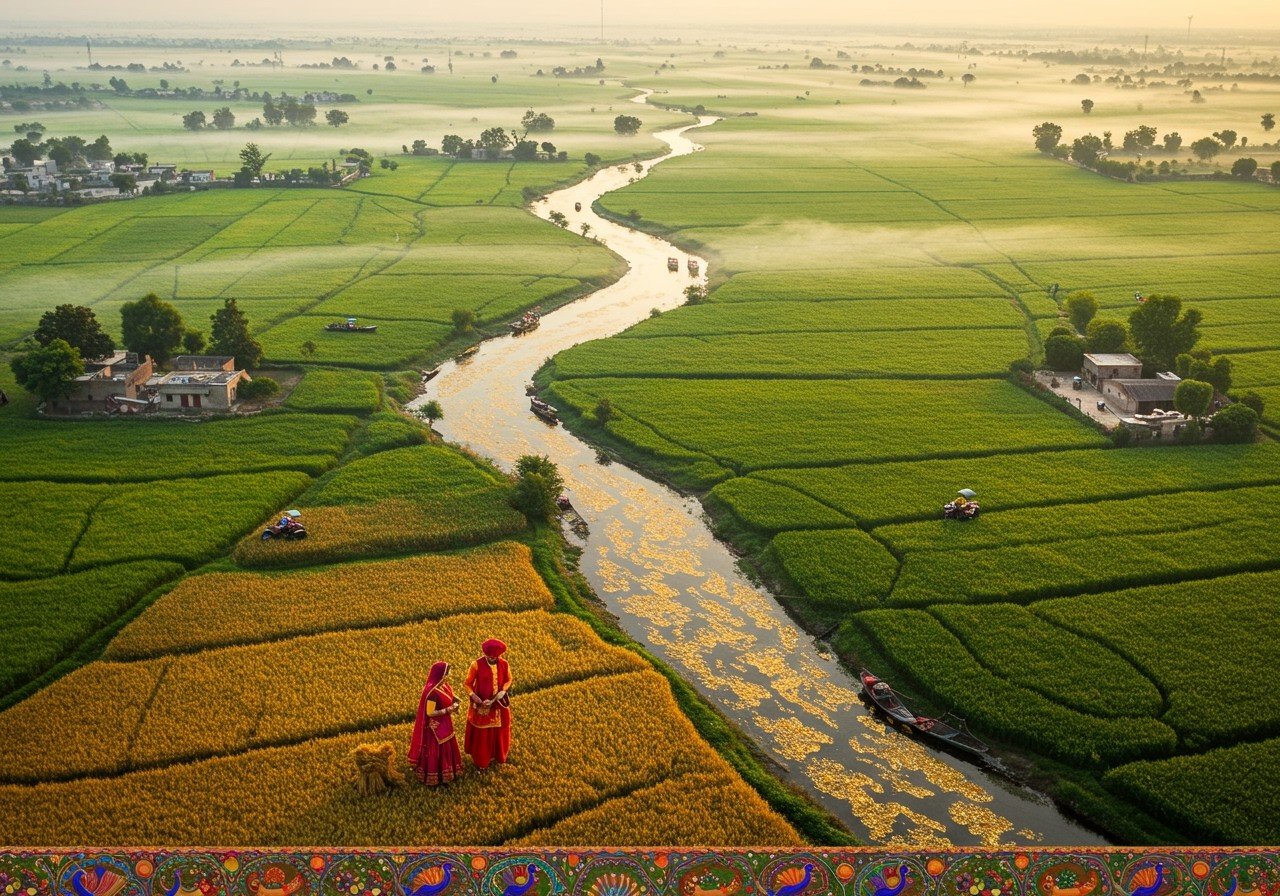
Punjab, often called the “breadbasket of India,” is renowned for its rich cultural heritage and agricultural prosperity. This article delves into Punjab’s geography, exploring why it’s known as the land of five rivers, the factors contributing to its fertile plains, and its strategic location on the India map. By understanding these elements, we can better appreciate Punjab’s economic and cultural significance.
The Five Rivers of Punjab
The name “Punjab” originates from the Persian words “panj” (five) and “ab” (water), referring to the five major rivers that flow through the region: Sutlej, Beas, Ravi, Chenab, and Jhelum. These rivers, tributaries of the Indus, played a crucial role in ancient civilizations, including the Indus Valley Civilization. They have profoundly shaped agricultural practices and lifestyles in Punjab.
- Major Cities: Amritsar, Ludhiana, and Jalandhar, vital cultural and economic centers, developed along these rivers, benefiting from the water resources and transportation routes they offered. The rivers have historically served as lifelines for these cities, providing water for domestic use, irrigation, and trade.
- Irrigation: Punjab boasts the world’s largest canal irrigation system, a testament to the significance of these rivers for agriculture. This extensive network of canals ensures a consistent water supply to the vast agricultural lands, supporting high crop yields and contributing to Punjab’s status as a major agricultural producer.
The Fertility of Punjab’s Plains
Several factors contribute to the exceptional fertility of Punjab’s plains:
- Alluvial Soil: Deposited by the five rivers over centuries, the alluvial soil is incredibly rich in nutrients, providing an ideal foundation for agriculture. This fertile soil is constantly replenished by the rivers, ensuring a continuous supply of essential nutrients for crops.
- Topography: The flat and gently undulating plains of Punjab are perfectly suited for farming, facilitating efficient irrigation and cultivation. This topography also allows for the easy use of modern agricultural machinery, further enhancing productivity.
- Climate: Punjab experiences a mix of tropical and subtropical weather, creating favorable conditions for a variety of crops. The region receives adequate sunlight and rainfall, essential for healthy crop growth.
- Irrigation: Advanced irrigation techniques, including canals and tube wells, ensure a consistent water supply, even during dry periods. This reliable water access is crucial for maximizing crop yields and maintaining agricultural productivity.
The Green Revolution of the 1960s and 1970s further enhanced Punjab’s agricultural output through the introduction of high-yield seeds, fertilizers, and modern equipment. Sustainable practices like crop rotation and diversification help maintain soil fertility, while government policies and subsidies provide crucial support to the agricultural sector.
Punjab’s Location and Strategic Significance
Punjab is located in northwestern India, bordered by Pakistan to the west. Its geographical coordinates are between 29°32’N to 32°32’N latitude and 73°55’E to 76°50’E longitude, covering an area of 50,362 square kilometers. Punjab also shares borders with Jammu and Kashmir to the north, Himachal Pradesh to the northeast, Haryana to the south and southeast, and Rajasthan to the southwest. This strategic location has significant implications for trade, defense, and cultural exchange.
- Bordering Pakistan: Punjab’s proximity to Pakistan has a significant impact on trade relations, defense strategies, and cultural exchange between the two nations. This border region is a focal point for both cooperation and tension, influencing political and economic dynamics.
- Transportation Networks: A well-developed network of national highways, railways, and airports connects Punjab to other parts of India, facilitating trade and transportation. These transportation links are crucial for the movement of agricultural goods and contribute to Punjab’s economic integration with the rest of the country.
- Defense Infrastructure: Due to its strategic border location, Punjab houses several military bases and border security installations, playing a vital role in national defense. The state’s security apparatus is crucial for maintaining peace and stability in the region.
Economic and Cultural Impact
Punjab’s fertile plains and abundant water resources make it a leading agricultural state. Its strategic location has shaped its role in trade and defense. The rich alluvial soil supports diverse crops like wheat, rice, sugarcane, and cotton, contributing significantly to India’s food security.
This agricultural abundance is deeply intertwined with Punjab’s culture and traditions. Festivals like Baisakhi celebrate harvests, while Punjabi cuisine, known for its wheat-based dishes and dairy products, showcases the region’s agricultural bounty. Music, dance forms like Bhangra and Gidda, and folklore also reflect the influence of the land and its resources.
Historical sites like the Golden Temple in Amritsar draw tourists globally. The state’s architecture, including forts and palaces, reflects its historical significance. Attractions like the Wagah Border ceremony highlight Punjab’s vibrant culture.
Connecting with Punjab’s Heritage through Poojn.in
Poojn.in, India’s leading online store for cultural and religious goods, offers a wide range of products that resonate with Punjab’s rich traditions. Whether you’re seeking items for personal prayer, home rituals, or festive celebrations, Poojn.in provides authentic and high-quality products that connect you with Punjab’s spiritual heritage.
- Prayer and Meditation: Enhance your spiritual practice with premium-quality prayer mats, meditation asanas, and other essential items sourced from across India, including Punjab. These products are crafted with traditional techniques and materials, ensuring authenticity and reverence.
- Puja Essentials: Find everything you need for traditional Punjabi pujas, including incense, diyas, and offering plates. Poojn.in offers a diverse selection of puja items, ensuring you can find everything required for your specific rituals and ceremonies.
- Deities and Murtis: Explore a wide collection of beautifully crafted murtis and deities that represent Punjab’s rich religious heritage. These sacred representations are crafted with meticulous detail and reverence, adding a spiritual touch to your home or prayer space.
By understanding Punjab’s geography, we gain a deeper appreciation for its contributions to India’s heritage. The region’s natural resources continue to play a crucial role in its economy and culture. Embracing and preserving these traditions while utilizing modern advancements ensures a prosperous future for this vibrant state.
Hanuman’s Journey: Devotion, Strength, and Epic Tale
Lord Rama: Ideal Leadership and Virtue
Hindu Philosophy Explained: A Beginner’s Guide


